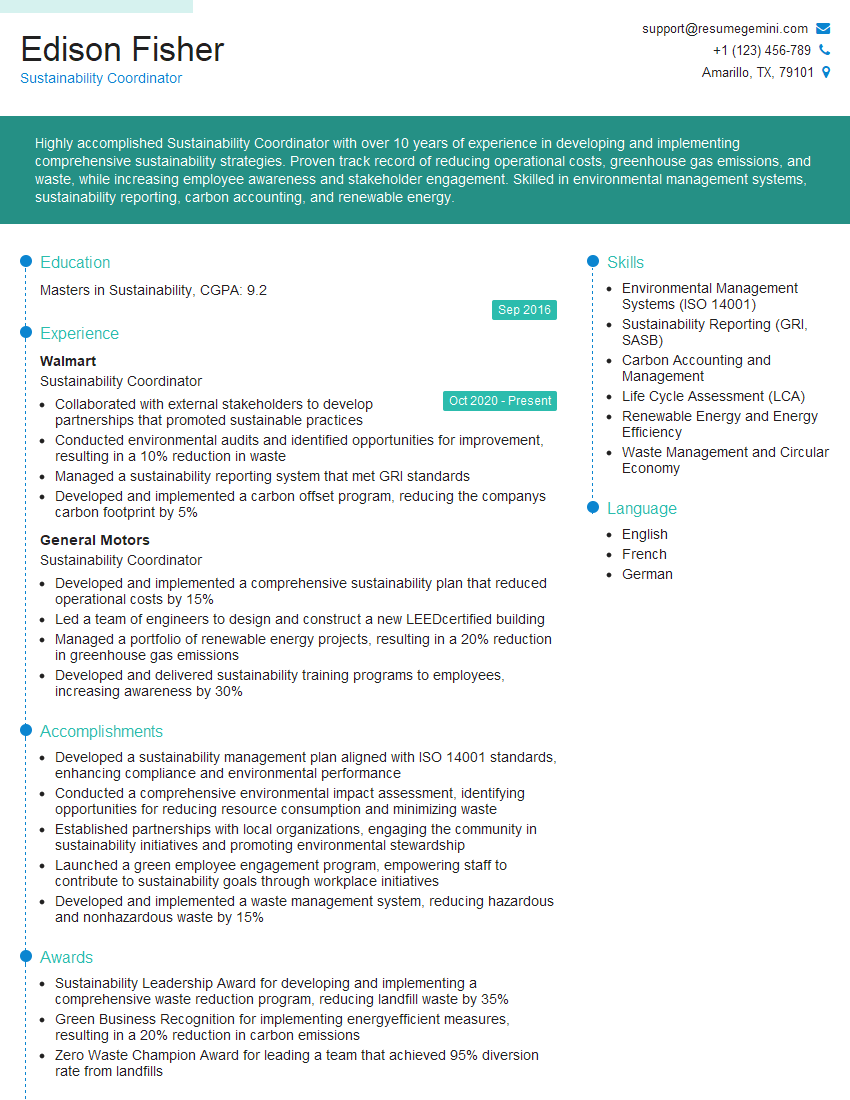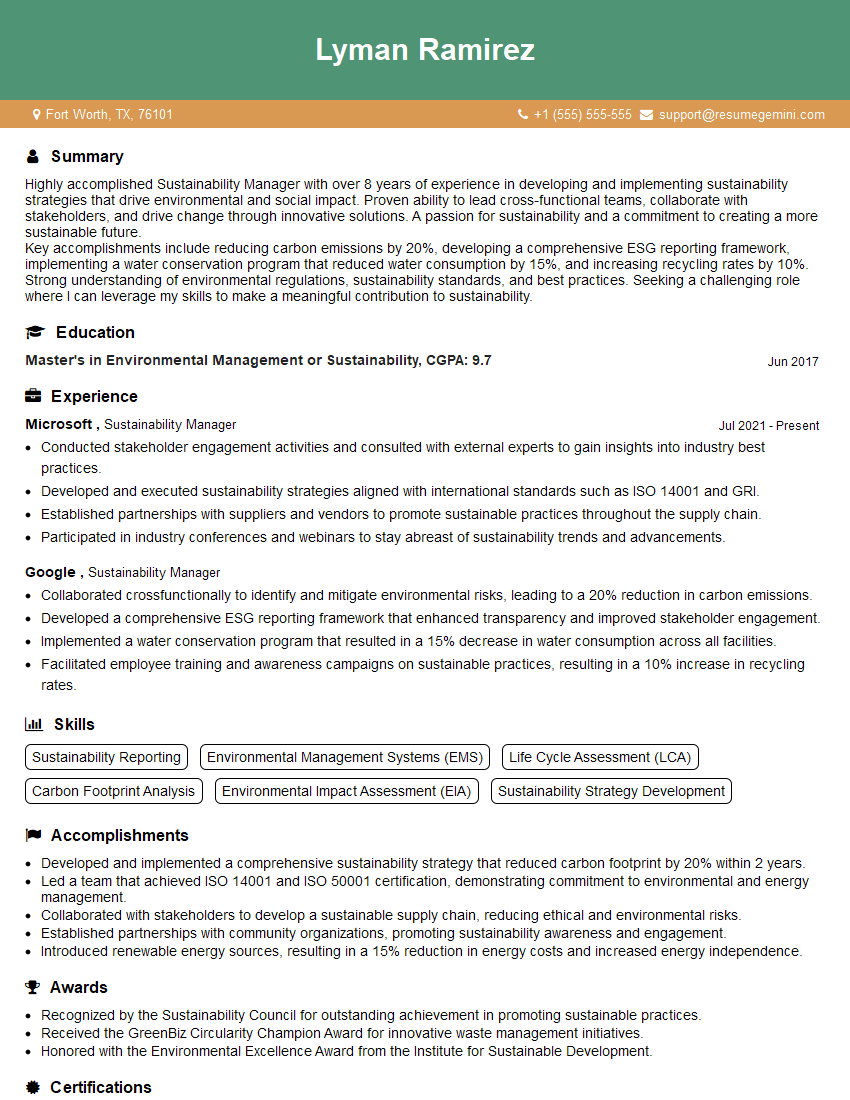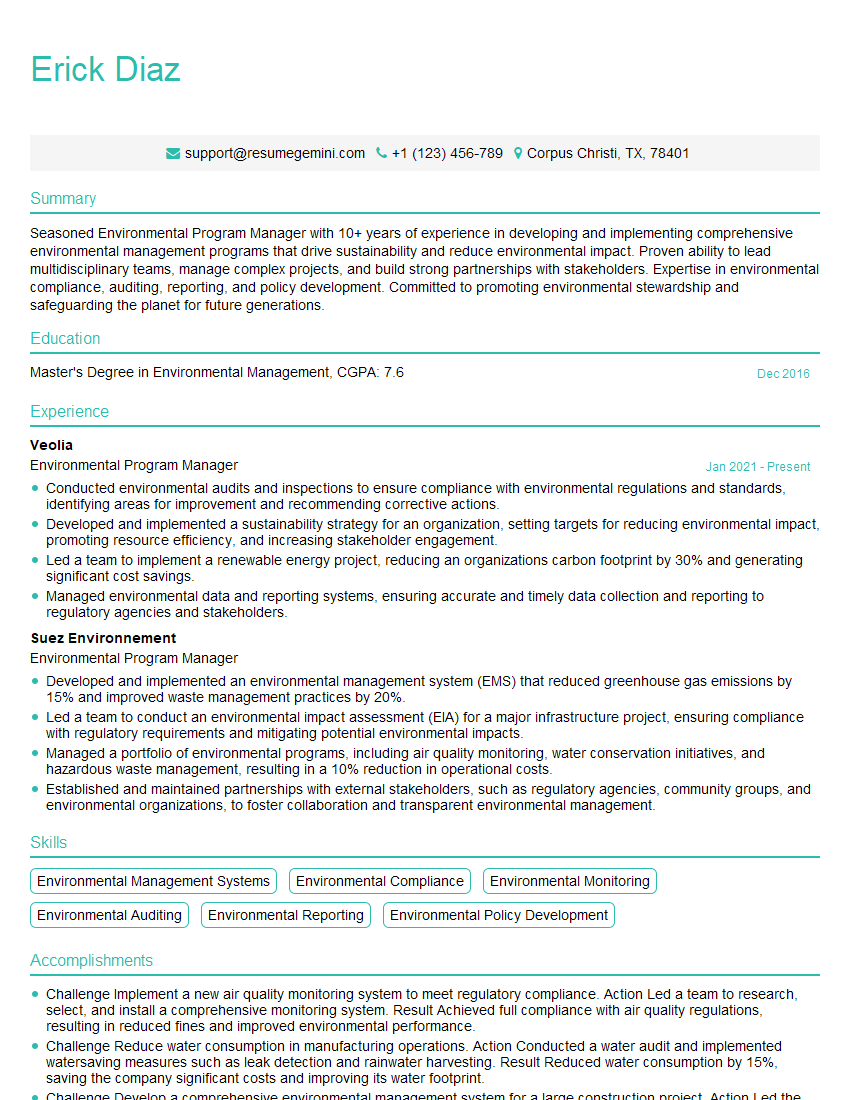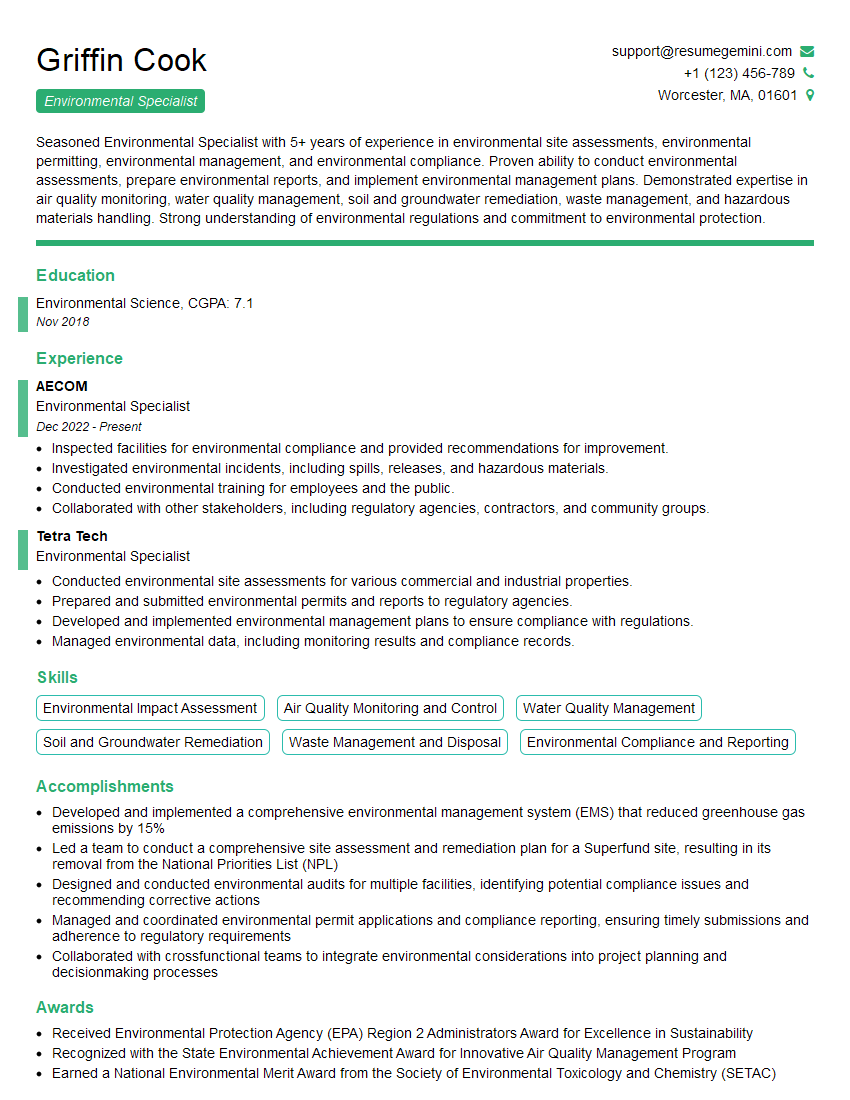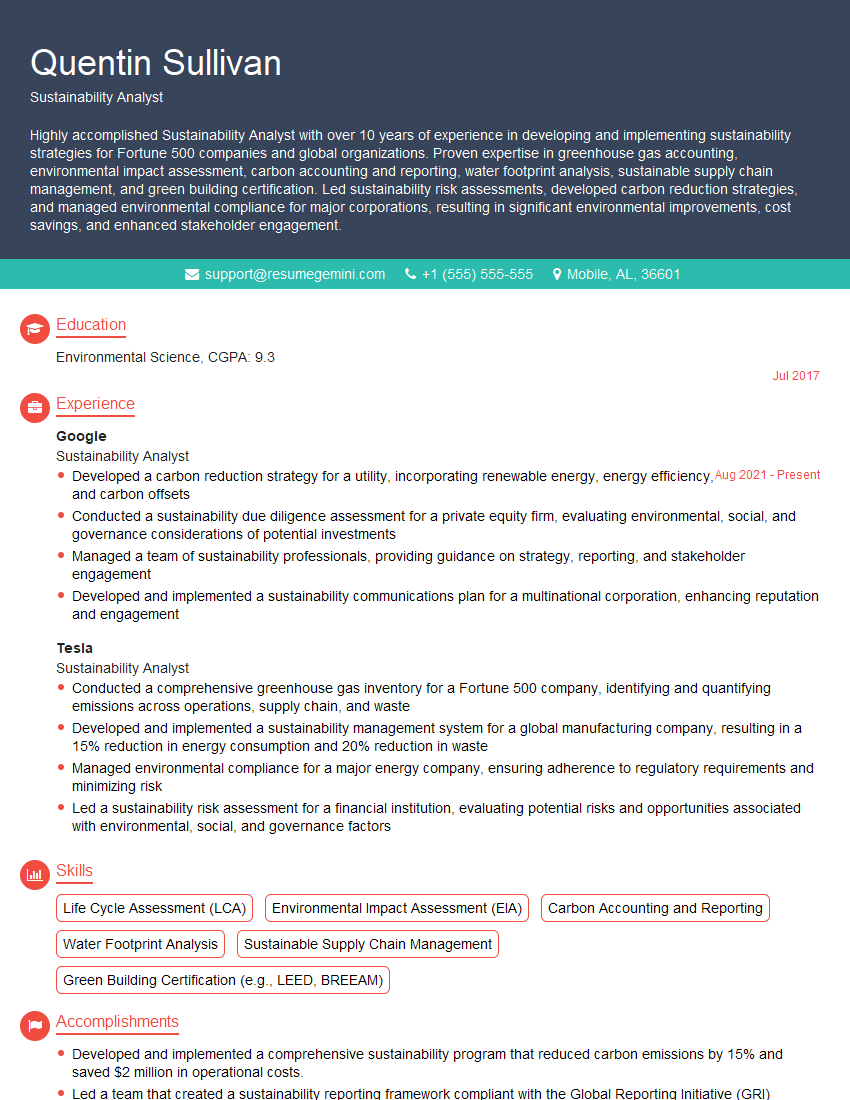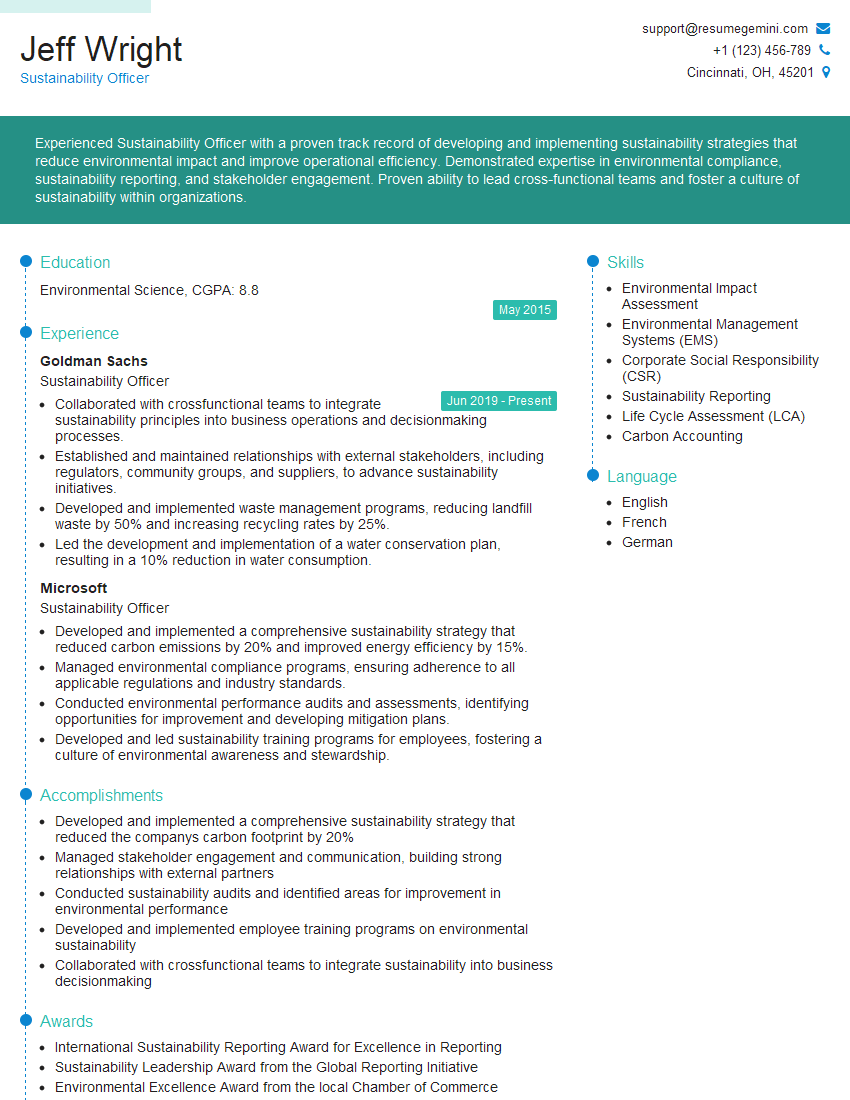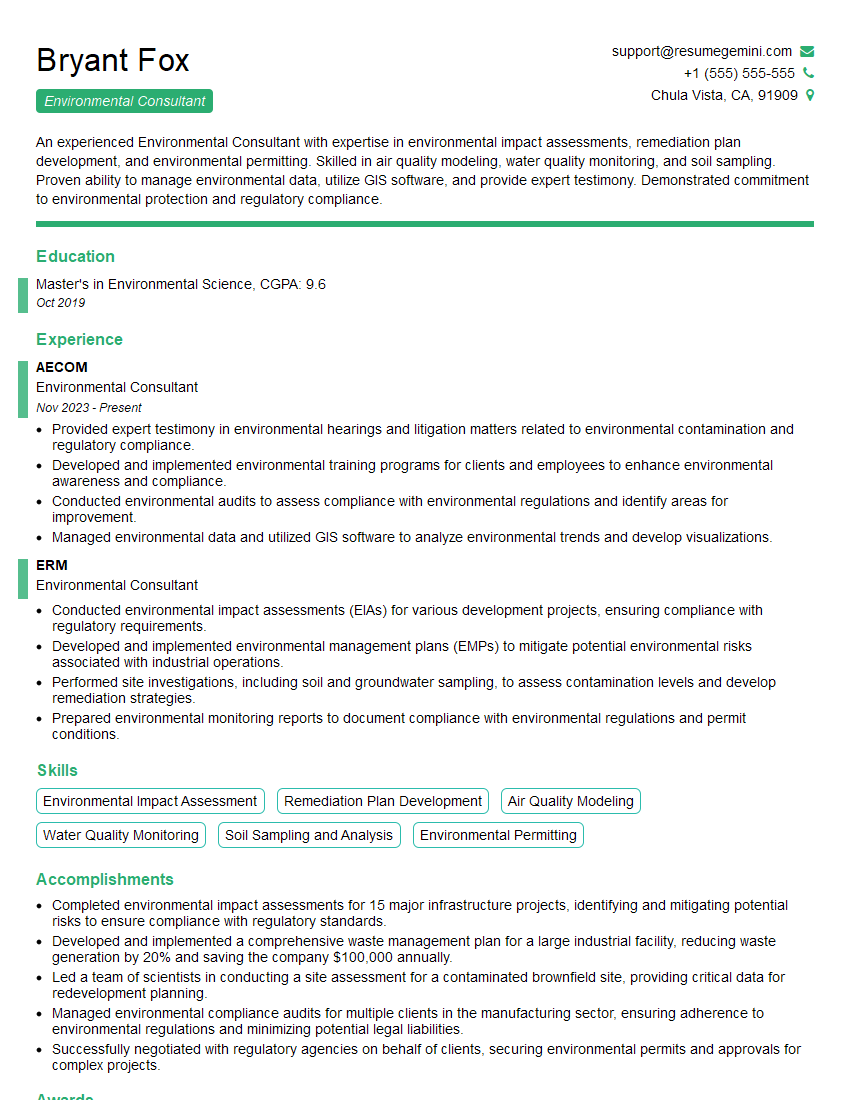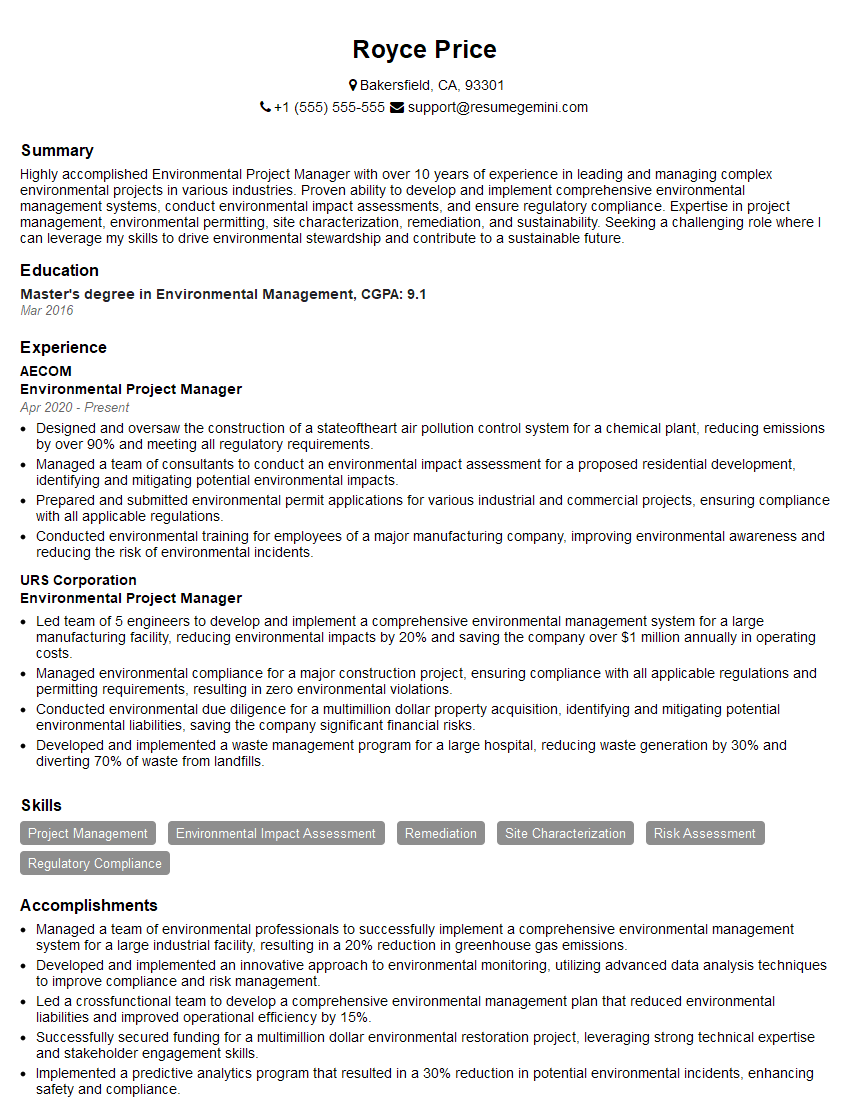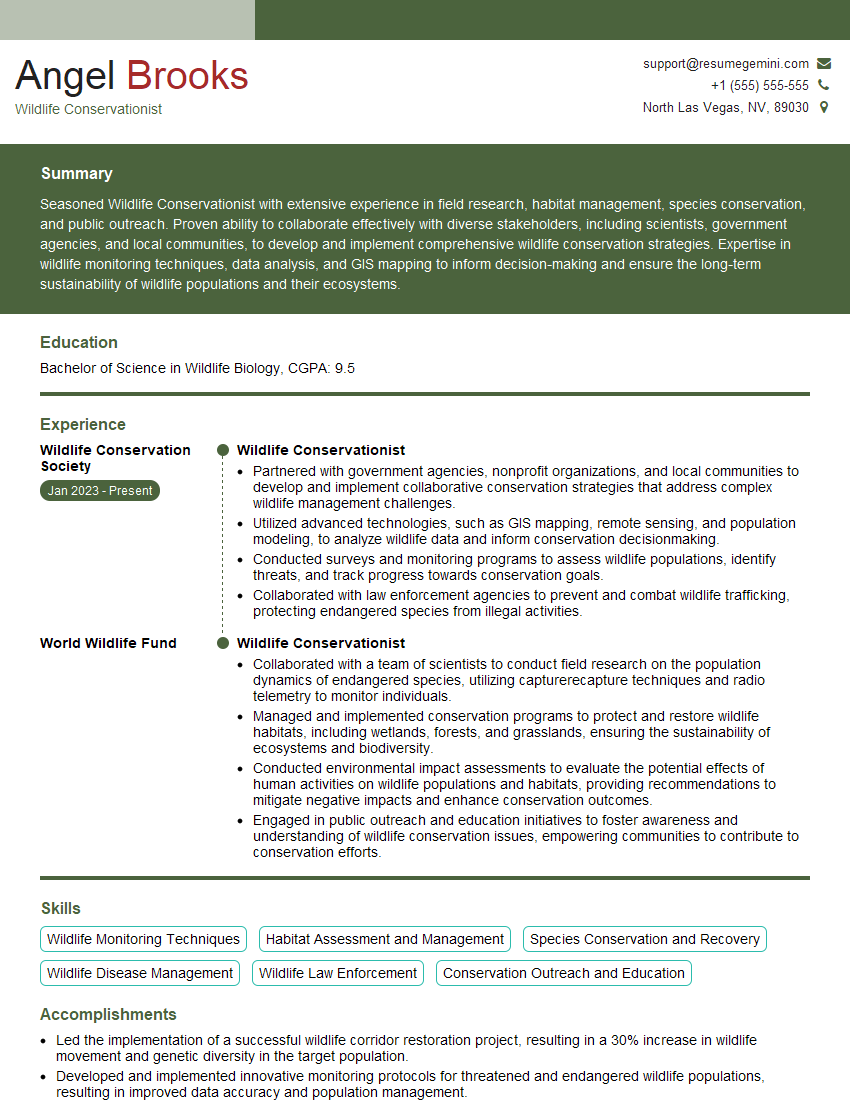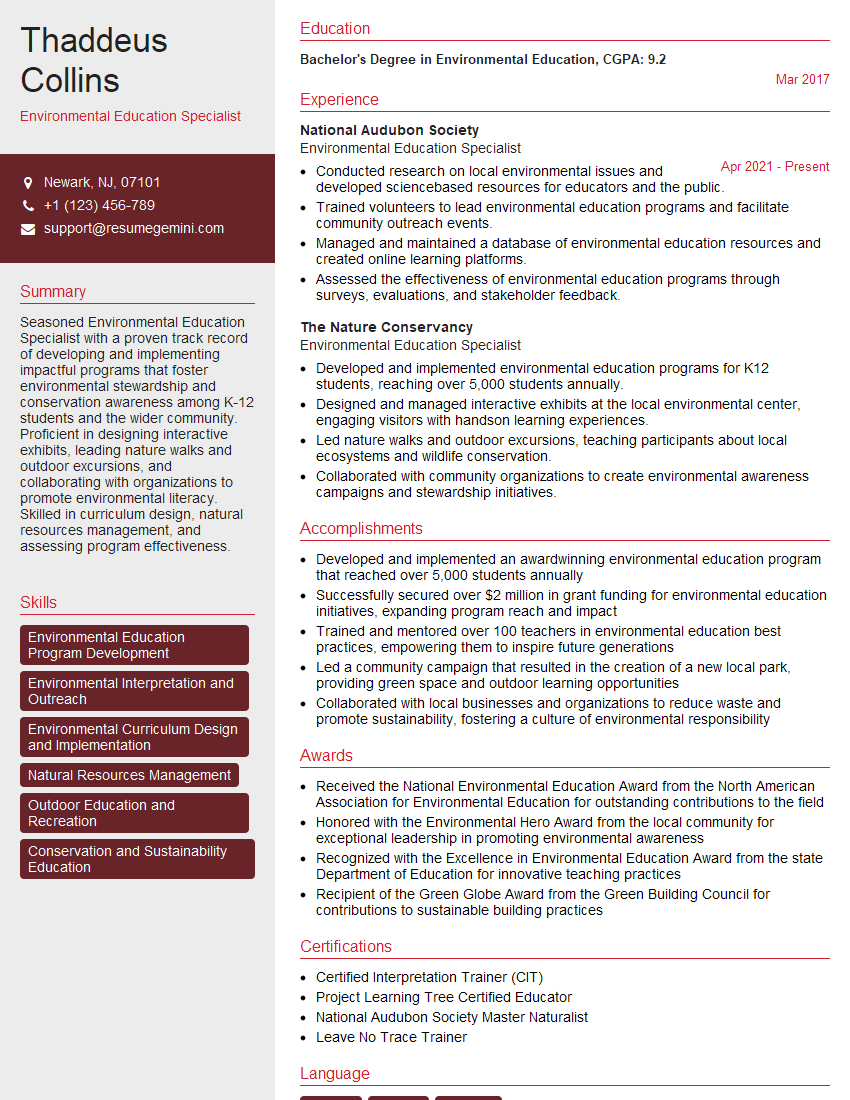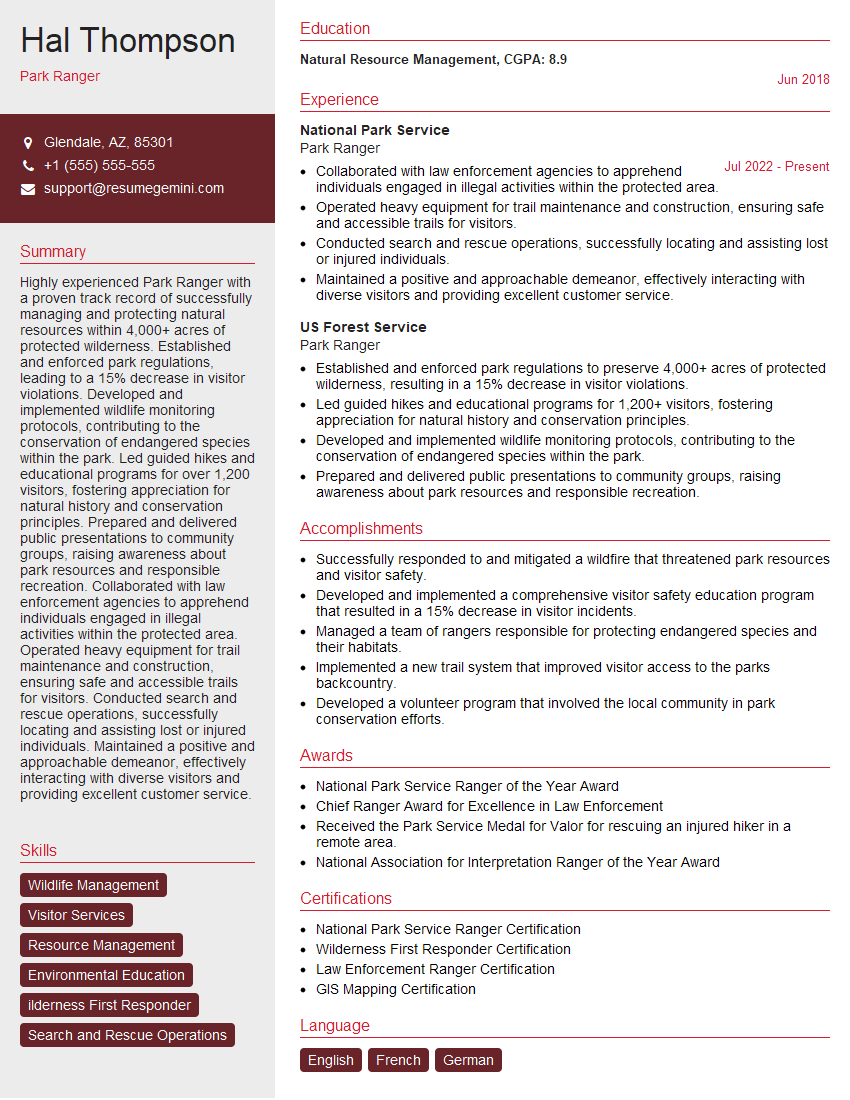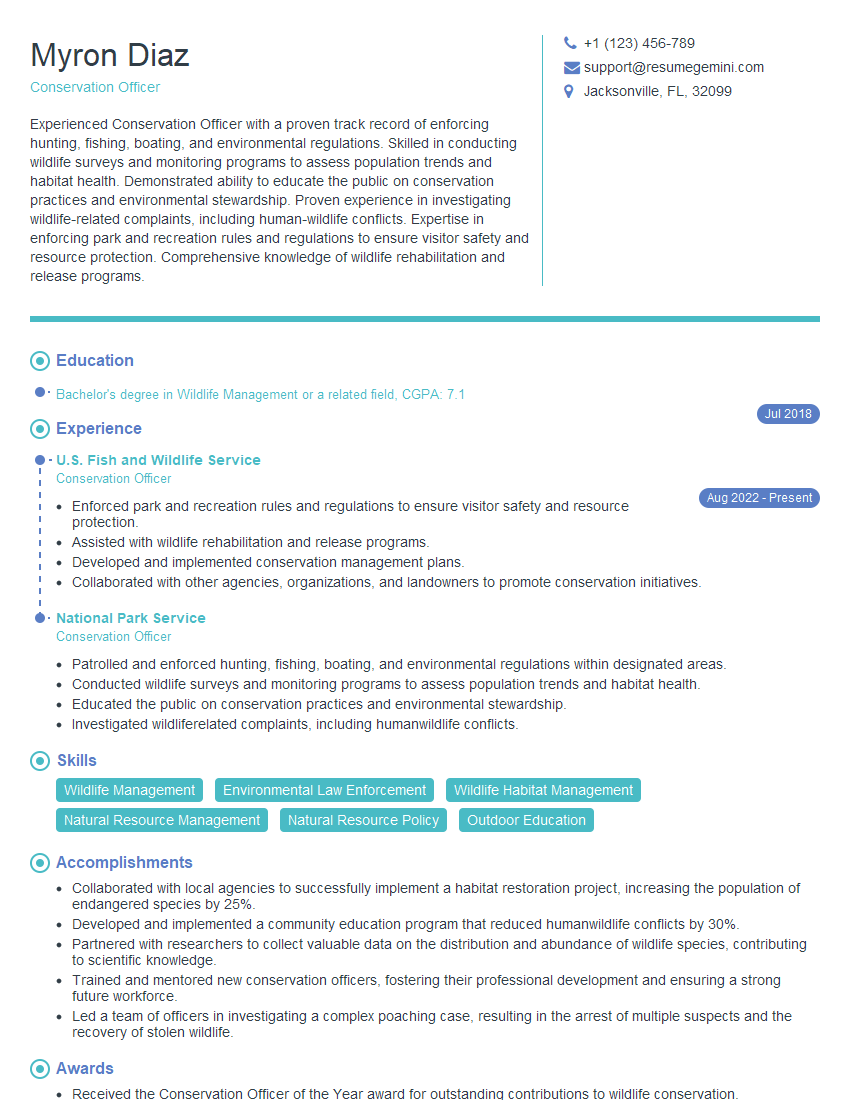Cracking a skill-specific interview, like one for Sustainability and Eco-tourism Awareness, requires understanding the nuances of the role. In this blog, we present the questions you’re most likely to encounter, along with insights into how to answer them effectively. Let’s ensure you’re ready to make a strong impression.
Questions Asked in Sustainability and Eco-tourism Awareness Interview
Q 1. Define sustainable tourism and its key principles.
Sustainable tourism is tourism that takes full account of its current and future economic, social and environmental impacts, addressing the needs of visitors, the industry, the environment and host communities.
Its key principles revolve around minimizing negative impacts and maximizing positive contributions. These include:
- Environmental protection: Conserving natural resources, minimizing pollution, and protecting biodiversity.
- Socio-cultural integrity: Respecting local cultures, traditions, and communities, ensuring their well-being and active participation.
- Economic viability: Ensuring that tourism contributes to sustainable economic development, distributing benefits fairly among stakeholders.
- Visitor satisfaction: Providing high-quality experiences that are enjoyable and enriching for tourists while promoting responsible behavior.
For example, a sustainable tour operator might choose to use locally-sourced food, employ local guides, and support community-based conservation projects, instead of relying on mass-produced imports and harming the environment.
Q 2. Explain the concept of a carbon footprint and how it relates to eco-tourism.
A carbon footprint represents the total amount of greenhouse gases (like carbon dioxide, methane, and nitrous oxide) generated by our actions. In eco-tourism, it refers to the emissions resulting from travel, accommodation, activities, and consumption related to a tourist trip.
A large carbon footprint from eco-tourism can undermine its very purpose. Flights, for instance, contribute significantly to a tourist’s carbon footprint. Eco-tourism aims to mitigate this through carbon offsetting (investing in projects that reduce emissions elsewhere) or by promoting sustainable transportation like trains or electric vehicles.
Think of it like this: A trip to a remote rainforest lodge might have a smaller carbon footprint if you travel by train and the lodge uses solar energy, compared to flying and staying in a hotel with high energy consumption.
Q 3. Describe different methods for measuring the environmental impact of tourism.
Measuring the environmental impact of tourism involves a multifaceted approach using various methods. These include:
- Life Cycle Assessment (LCA): This comprehensive method analyzes the environmental impacts of a tourism product or activity throughout its entire life cycle, from resource extraction to waste disposal. It considers energy consumption, water usage, waste generation, and greenhouse gas emissions.
- Environmental Impact Assessment (EIA): This assesses the potential environmental effects of a specific tourism development or project, such as a new resort or infrastructure development. It identifies potential risks and suggests mitigation strategies.
- Carbon Footprint Analysis: This focuses specifically on calculating the greenhouse gas emissions associated with tourism activities, enabling the identification of emission hotspots and opportunities for reduction.
- Ecological Footprint Analysis: This method measures the demand placed on natural resources by tourism activities, comparing it to the Earth’s capacity to regenerate those resources. It helps assess sustainability on a broader scale.
- Waste Audits: These measure the amount and type of waste generated by tourism operations, revealing areas for improvement in waste management practices.
Combining these methods provides a more holistic understanding of tourism’s environmental impacts.
Q 4. What are the social and economic benefits of sustainable tourism practices?
Sustainable tourism practices offer numerous social and economic benefits:
- Social benefits: Preservation of cultural heritage, improved community relations, enhanced local pride, increased employment opportunities for local people, and empowerment of marginalized communities.
- Economic benefits: Increased revenue generation for local businesses and communities, job creation, diversification of local economies, reduced dependence on single industries, and improved infrastructure development.
For example, community-based tourism initiatives can empower local communities by allowing them to manage and benefit directly from tourism revenue. This fosters economic independence and a sense of ownership in preserving their natural and cultural resources.
Q 5. How can eco-tourism contribute to biodiversity conservation?
Eco-tourism can significantly contribute to biodiversity conservation through several mechanisms:
- Funding for conservation efforts: Eco-tourism generates revenue that can be directly invested in conservation programs, park management, and anti-poaching initiatives.
- Habitat protection: Sustainable tourism practices often involve protecting and restoring natural habitats, providing refuge for endangered species.
- Awareness and education: Eco-tourism exposes visitors to the importance of biodiversity, promoting conservation awareness and responsible behavior among tourists.
- Community engagement: Local communities involved in eco-tourism are often incentivized to protect their natural resources for long-term economic gains.
For example, ecotourism lodges in the Amazon rainforest often employ local guides and reinvest a portion of their profits into protecting the rainforest’s unique biodiversity. This creates a mutually beneficial relationship between conservation and tourism.
Q 6. Explain the role of certifications (e.g., Green Globe, LEED) in sustainable tourism.
Certifications like Green Globe and LEED play a crucial role in promoting and ensuring sustainable tourism practices. These certifications provide independent verification that a tourism business meets specific environmental and social standards.
They act as a quality assurance mark, increasing consumer confidence in a business’s commitment to sustainability. Furthermore, they help businesses identify areas for improvement and track their progress towards greater sustainability. They also provide a common framework for comparing the sustainability performance of different tourism operators.
The process of obtaining these certifications often involves rigorous audits and assessments, demonstrating a genuine commitment to sustainability beyond simple marketing claims.
Q 7. What are some challenges faced in implementing sustainable tourism initiatives?
Implementing sustainable tourism initiatives faces several challenges:
- Balancing economic development with environmental protection: Finding the right balance between generating economic benefits and preserving the environment can be complex.
- Community involvement and benefit-sharing: Ensuring that local communities are actively involved in tourism development and fairly benefit from it can be challenging.
- Measuring and monitoring impact: Accurately measuring the environmental and social impacts of tourism requires sophisticated monitoring systems and data analysis.
- Enforcing regulations and standards: Effective enforcement of regulations and standards is crucial to ensure that tourism businesses adhere to sustainable practices.
- Addressing the challenges of mass tourism: Managing the environmental and social impacts of large numbers of tourists requires careful planning and management.
- Lack of awareness and education: Raising awareness among both tourists and tourism operators about sustainable practices is crucial.
Overcoming these challenges requires collaborative efforts between governments, tourism businesses, local communities, and tourists themselves.
Q 8. How can technology be used to enhance sustainable tourism practices?
Technology plays a crucial role in boosting sustainable tourism. Imagine a world where tourists can easily access real-time information about a destination’s ecological footprint, helping them make informed choices. This is achievable through various technological tools.
Mobile Apps: Apps can provide information on eco-friendly accommodations, transportation options (like bike rentals or electric vehicle charging stations), and sustainable activities. They can also act as digital guides, reducing the need for paper maps and brochures.
GPS Tracking and Monitoring: Technology allows for monitoring of tourist foot traffic in sensitive ecological areas. This helps identify areas needing more protection or better management strategies, preventing over-tourism and ecological damage.
Online Booking Platforms: These platforms can highlight eco-certified businesses and accommodations, making it easy for tourists to choose sustainable options. They can also incorporate carbon offsetting programs directly into the booking process.
Smart Sensors and Data Analytics: Sensors can monitor energy consumption in eco-lodges and other facilities, enabling data-driven decisions for energy efficiency improvements. Analytics can help identify patterns in tourist behavior to understand and manage the impact on local ecosystems.
For example, a national park could use an app to direct tourists to less crowded trails, reducing the impact on fragile ecosystems. Similarly, an eco-lodge could use smart sensors to monitor energy and water usage, improving efficiency and reducing its environmental footprint.
Q 9. Discuss the importance of community involvement in sustainable tourism development.
Community involvement is absolutely fundamental to sustainable tourism. It’s not just about preserving the environment; it’s about ensuring that local communities benefit economically and culturally from tourism while also safeguarding their heritage.
Economic Benefits: Sustainable tourism models prioritize local businesses, creating employment opportunities within the community. Think of locally owned restaurants, tour guides, and artisan shops thriving because of responsible tourism.
Cultural Preservation: Local communities are the custodians of their culture and traditions. Their involvement ensures that tourism respects and celebrates their unique heritage, rather than commodifying or eroding it.
Environmental Stewardship: Local communities often have a deep understanding of their environment and possess traditional ecological knowledge. Their participation ensures sustainable practices are adopted and enforced effectively.
Empowerment and Ownership: Meaningful involvement empowers local communities to own and manage their tourism resources, fostering a sense of pride and responsibility.
For instance, a village might develop a community-based ecotourism project, managing trails, guiding visitors, and offering homestays, ensuring that revenue directly benefits its residents while protecting their natural surroundings.
Q 10. Describe strategies for minimizing waste and pollution in eco-tourism destinations.
Minimizing waste and pollution in eco-tourism destinations requires a multi-pronged approach, focusing on waste reduction, recycling, and responsible waste disposal.
Reduce, Reuse, Recycle: Implementing a robust waste management system is key. This includes promoting the ‘reduce, reuse, recycle’ mantra, encouraging the use of reusable items, providing recycling facilities, and composting organic waste.
Sustainable Packaging: Encouraging businesses to use biodegradable and compostable packaging for food and other products is vital. This minimizes plastic waste and its environmental impact.
Wastewater Treatment: Eco-lodges and other tourism facilities should invest in proper wastewater treatment systems to prevent pollution of local water bodies.
Responsible Disposal of Hazardous Waste: Proper disposal procedures for hazardous materials like batteries and chemicals must be in place to prevent environmental contamination.
Education and Awareness Campaigns: Educating tourists and local communities about the importance of waste reduction and proper waste management is crucial for long-term success.
For example, a resort could implement a comprehensive recycling program, partner with local farmers to compost food waste, and provide clear signage to guide tourists on waste disposal.
Q 11. How can you educate tourists about sustainable practices?
Educating tourists about sustainable practices is paramount. It’s about shifting mindsets and encouraging responsible behavior.
Pre-Trip Information: Provide clear and concise information about sustainable practices before tourists arrive. This can be done through brochures, websites, or email communications.
On-Site Education: Use signage, workshops, or guided tours to highlight the importance of conserving resources, respecting local cultures, and minimizing environmental impact.
Interactive Programs: Engage tourists through interactive activities, such as nature walks, workshops on local crafts, or volunteer opportunities that promote conservation.
Collaboration with Local Guides: Train local guides to integrate sustainable tourism messages into their tours, sharing their knowledge and passion for their environment and culture.
Incentivize Sustainable Behavior: Reward sustainable choices by tourists, such as offering discounts for using public transportation or reducing water and energy consumption.
Imagine a tour operator providing detailed information about the ecological sensitivity of a rainforest and educating tourists on how to minimize their impact during hikes. This proactive approach is a great example of effective education.
Q 12. Explain the concept of carrying capacity in relation to eco-tourism.
Carrying capacity refers to the maximum number of tourists an area can support without causing unacceptable environmental, social, or economic damage. It’s about finding a balance between tourism development and environmental protection.
There are different types of carrying capacity:
Environmental Carrying Capacity: This refers to the limit of the environment’s ability to absorb the impacts of tourism without significant degradation. It considers factors like water availability, waste disposal capacity, and the resilience of ecosystems.
Social Carrying Capacity: This focuses on the community’s tolerance for the presence of tourists. It considers the impact on local lifestyles, cultural values, and the quality of life for residents.
Economic Carrying Capacity: This refers to the capacity of the local economy to absorb the impacts of tourism while maintaining its stability and providing equitable benefits.
Determining carrying capacity involves careful assessment of these factors and often requires collaboration between tourism stakeholders, scientists, and local communities. Exceeding carrying capacity can lead to over-tourism, environmental degradation, and dissatisfaction among both tourists and residents. For example, a small island nation might have a limited environmental carrying capacity due to its fragile coral reefs, necessitating strict limits on the number of tourists.
Q 13. How do you assess the environmental risks associated with a tourism project?
Assessing environmental risks associated with a tourism project requires a systematic approach.
Environmental Impact Assessment (EIA): Conducting a thorough EIA is crucial. This process identifies potential environmental impacts, both positive and negative, of a proposed tourism development.
Baseline Data Collection: Gathering data on the existing environmental conditions before the project starts is essential to provide a benchmark for comparison.
Risk Identification and Analysis: Identify potential environmental risks, such as habitat destruction, pollution, water depletion, and impacts on biodiversity.
Mitigation Strategies: Develop strategies to mitigate identified risks. This could involve implementing sustainable practices, creating protected areas, or employing environmental monitoring programs.
Stakeholder Consultation: Engage local communities, environmental organizations, and government agencies in the risk assessment process.
For example, a proposed resort development near a coastal wetland would need to assess the potential impacts on water quality, wildlife habitat, and coastal erosion. Mitigation strategies could include wastewater treatment, construction restrictions in sensitive areas, and wetland restoration projects.
Q 14. What are some effective strategies for reducing the energy consumption of eco-lodges?
Reducing energy consumption in eco-lodges is essential for minimizing their environmental footprint.
Energy-Efficient Design: Building design plays a crucial role. Features like natural ventilation, passive solar design, and insulation can significantly reduce the need for artificial heating and cooling.
Renewable Energy Sources: Investing in renewable energy sources like solar panels, wind turbines, or geothermal energy can dramatically reduce reliance on fossil fuels.
Energy-Efficient Appliances and Lighting: Using energy-efficient appliances, lighting (LEDs), and HVAC systems can dramatically reduce energy consumption.
Smart Energy Management Systems: Implementing smart energy management systems allows for real-time monitoring and control of energy usage, identifying areas for improvement.
Energy Audits and Efficiency Improvements: Regular energy audits can help identify areas where energy consumption can be reduced.
For example, an eco-lodge could incorporate solar panels to power its electricity needs, utilize energy-efficient appliances, and install smart thermostats to optimize heating and cooling.
Q 15. Describe different approaches to sustainable transportation in eco-tourism.
Sustainable transportation in eco-tourism prioritizes minimizing the environmental footprint of travel. This involves a multifaceted approach, moving away from reliance on high-emission vehicles.
- Walking and Cycling: Promoting walking and cycling tours, particularly in areas with well-maintained trails, reduces emissions and offers a more immersive experience for tourists.
- Public Transportation: Encouraging the use of trains, buses, and ferries instead of private vehicles reduces congestion and pollution. Effective integration with tourist routes is crucial.
- Electric Vehicles: Utilizing electric vehicles for transfers and tours minimizes direct emissions. This requires infrastructure development like charging stations, particularly in remote areas.
- Water Transportation: Utilizing boats, kayaks, or canoes for travel in suitable locations offers a sustainable alternative, especially in areas where roads are limited or environmentally sensitive.
- Shared Transportation: Implementing ride-sharing programs or utilizing shuttle services to transfer tourists from airports or train stations to accommodations reduces the number of vehicles on the road.
For instance, a community-based eco-tourism initiative in Costa Rica successfully switched from using gas-guzzling jeeps for rainforest tours to electric golf carts, reducing their carbon footprint significantly while simultaneously improving the visitor experience with quieter and more environmentally friendly transport.
Career Expert Tips:
- Ace those interviews! Prepare effectively by reviewing the Top 50 Most Common Interview Questions on ResumeGemini.
- Navigate your job search with confidence! Explore a wide range of Career Tips on ResumeGemini. Learn about common challenges and recommendations to overcome them.
- Craft the perfect resume! Master the Art of Resume Writing with ResumeGemini’s guide. Showcase your unique qualifications and achievements effectively.
- Don’t miss out on holiday savings! Build your dream resume with ResumeGemini’s ATS optimized templates.
Q 16. How can eco-tourism contribute to local economic development?
Eco-tourism offers a powerful mechanism for driving local economic development, primarily by creating job opportunities and generating revenue within communities. It’s about fostering a sustainable economic model that benefits local populations directly.
- Job Creation: Eco-tourism creates numerous employment opportunities, ranging from guides and drivers to hospitality staff and artisans. Local communities gain skills and income from working directly with tourists.
- Revenue Generation: Tourists spend money on accommodations, food, activities, souvenirs, and transportation, directly benefiting local businesses and entrepreneurs.
- Community Empowerment: Successful eco-tourism initiatives empower communities by placing them at the heart of the process, giving them control over their resources and allowing them to define the tourism experience.
- Preservation of Cultural Heritage: By showcasing local traditions, crafts, and history, eco-tourism helps preserve cultural heritage and provides a source of income for communities involved in maintaining them.
For example, in the Maasai Mara, Kenya, local communities are actively involved in managing tourism, earning income from guiding safaris, providing accommodation, and selling crafts, thus improving their livelihoods without compromising the natural environment.
Q 17. What is your experience with environmental impact assessments?
Environmental Impact Assessments (EIAs) are crucial for responsible tourism development. My experience encompasses conducting, reviewing, and managing EIAs across diverse eco-tourism projects.
I’ve been involved in numerous projects where we meticulously evaluated potential environmental impacts, ranging from habitat destruction and pollution to waste management and resource depletion. This involved fieldwork, data analysis, stakeholder consultation, and the development of mitigation strategies. I’m adept at using various methodologies such as matrix analysis, checklists, and geographic information systems (GIS) to conduct comprehensive EIAs.
For instance, in a project in the Galapagos Islands, I led a team that assessed the environmental impact of a proposed new eco-lodge. We identified potential impacts on local flora and fauna, water resources, and waste disposal and developed a mitigation plan that included waste recycling systems, water conservation measures, and sustainable building materials.
Q 18. How familiar are you with international sustainability standards and guidelines?
I am highly familiar with international sustainability standards and guidelines related to tourism, including the Global Sustainable Tourism Council (GSTC) criteria, the ISO 20121 standard for sustainable event management, and various national park regulations and best practices.
My understanding extends to various certification programs like Green Globe and LEED, as well as frameworks for carbon footprint calculation and reduction. I can readily apply these standards to the development and implementation of sustainable tourism initiatives and can assess the sustainability performance of tourism businesses against these benchmarks. Understanding these guidelines allows for a standardized and universally accepted approach to sustainable tourism practices.
Q 19. Describe your experience in developing and implementing sustainability plans.
I have extensive experience in developing and implementing sustainability plans for various tourism businesses and destinations. This includes collaborating with stakeholders, setting targets, developing action plans, monitoring progress, and reporting results.
My approach is highly participatory, involving all stakeholders – from local communities and businesses to government agencies and environmental organizations. I utilize a variety of tools and techniques, including stakeholder analysis, SWOT analysis, materiality assessments, and risk management frameworks. My work often involves developing key performance indicators (KPIs) to measure progress toward sustainability goals. A recent project involved creating a comprehensive sustainability plan for a resort in Southeast Asia, focusing on waste management, energy efficiency, water conservation, and community engagement. This resulted in significant reductions in the resort’s environmental footprint and tangible improvements in social impact.
Q 20. How would you handle a conflict between the needs of the local community and tourism development?
Conflicts between community needs and tourism development are common. Handling such conflicts requires a collaborative and participatory approach that prioritizes equitable benefit-sharing.
My strategy involves:
- Open Communication and Dialogue: Fostering open communication channels between all stakeholders to understand their concerns and perspectives.
- Participatory Planning: Engaging local communities in the planning process from the outset to ensure their needs are considered and their voices are heard.
- Benefit-Sharing Agreements: Establishing clear benefit-sharing mechanisms that ensure fair distribution of tourism revenue and resources among community members.
- Capacity Building: Providing training and skills development opportunities for community members to participate in and benefit from tourism activities.
- Conflict Resolution Mechanisms: Establishing clear conflict resolution processes and mechanisms to address disputes fairly and efficiently.
In one instance, I facilitated a mediation process between a tourism company and a local community who were in disagreement over land use rights near a proposed new attraction. Through facilitated dialogue and compromise, we developed a mutually agreeable solution that protected the community’s interests while enabling the tourism project to move forward sustainably.
Q 21. How can you mitigate the negative impacts of tourism on natural resources?
Mitigating the negative impacts of tourism on natural resources requires a proactive and multi-pronged approach focused on reducing consumption, waste generation, and pollution.
- Waste Management: Implementing robust waste management systems, including recycling, composting, and waste reduction programs. Educating tourists about responsible waste disposal is crucial.
- Water Conservation: Implementing water-saving technologies and practices in accommodations and tourism facilities. Educating tourists about responsible water usage is also essential.
- Energy Efficiency: Utilizing renewable energy sources, promoting energy-efficient technologies, and reducing energy consumption through behavioral change.
- Biodiversity Conservation: Protecting and restoring habitats, preventing the introduction of invasive species, and promoting sustainable wildlife viewing practices.
- Pollution Control: Minimizing air and water pollution through the use of cleaner transportation, responsible waste disposal, and pollution control technologies.
- Carrying Capacity Management: Limiting the number of tourists in sensitive areas to prevent overcrowding and environmental degradation.
For example, a successful initiative in a national park involved implementing a strict waste management system, including a deposit-refund scheme for reusable water bottles, reducing litter dramatically. This, coupled with educating visitors on the park’s fragile ecosystem, has led to a significant positive environmental outcome.
Q 22. Describe your experience in communicating sustainability concepts to diverse audiences.
Communicating sustainability to diverse audiences requires tailoring the message to resonate with their specific values and understanding. I’ve successfully done this through various methods, including interactive workshops, engaging presentations with visuals, and creating accessible materials like infographics and short videos. For example, when presenting to a community of local artisans, I emphasized the economic benefits of sustainable practices – showcasing how eco-tourism can increase their income through responsible tourism initiatives. Conversely, when speaking to environmental scientists, I focused on the detailed ecological impacts of different tourism models and the latest research on conservation efforts. The key is to find common ground and connect sustainability to their existing priorities, whether it’s economic prosperity, cultural preservation, or environmental protection.
- Workshops: Interactive sessions using games and discussions to actively involve participants.
- Visual aids: Infographics, videos, and photos to illustrate complex concepts simply.
- Storytelling: Sharing success stories of sustainable tourism projects to inspire action.
Q 23. Explain your understanding of circular economy principles in the context of eco-tourism.
A circular economy minimizes waste and maximizes resource utilization. In eco-tourism, this means designing tourism experiences that reduce environmental impact and support local communities. Think of it as a closed-loop system. For instance, instead of relying on disposable plastics, eco-lodges can implement composting systems and use reusable materials. Local food sourcing reduces transportation emissions and benefits local farmers. Waste generated by tourists can be recycled or composted, minimizing landfill waste. Furthermore, revenue generated from tourism can be reinvested in conservation projects, creating a positive feedback loop. The principles of reduce, reuse, recycle, and recover become central to sustainable operations. For example, a resort could implement a system where leftover food from restaurants is used to feed animals on their farm which in turn produces manure which is then used to fertilize gardens thus promoting a closed-loop system.
- Reduce: Minimize resource consumption through efficient design and practices.
- Reuse: Employ reusable items and materials instead of disposables.
- Recycle: Implement comprehensive recycling programs for waste management.
- Recover: Use waste products as resources or energy sources.
Q 24. What are some innovative solutions for promoting sustainable tourism?
Innovative solutions for sustainable tourism involve technology and community engagement. For example, using mobile apps to guide tourists on eco-friendly trails, reducing reliance on paper maps and minimizing environmental disruption. Another approach is community-based tourism, where local communities are directly involved in managing and benefitting from tourism activities, ensuring cultural preservation and equitable resource distribution. Blockchain technology can be utilized for transparent tracking of carbon emissions and sustainable practices. Carbon offsetting programs where tourists can compensate for their carbon footprint by investing in verified conservation projects are also gaining traction. Implementing sustainable certification programs can help promote eco-conscious tourism operators and attract responsible travelers. Finally, promoting slow tourism, encouraging travelers to stay longer in fewer destinations, fostering deeper connections with local cultures and minimizing the environmental impact.
- Mobile apps for eco-trails: Reducing reliance on paper maps.
- Community-based tourism: Empowering locals and preserving culture.
- Blockchain for transparency: Tracking carbon emissions and ethical practices.
- Carbon offsetting: Compensating for carbon footprint through conservation projects.
- Slow tourism: Encouraging longer stays and deeper connections.
Q 25. How do you stay updated on the latest trends and best practices in sustainable tourism?
Staying updated involves continuous learning and engagement with the sector’s leading organizations and publications. I regularly attend international conferences and workshops on sustainable tourism. I subscribe to leading journals like the Journal of Sustainable Tourism and actively participate in online communities and forums. I also follow reputable organizations like the Global Sustainable Tourism Council (GSTC) for their guidelines and best practices. Monitoring industry reports and case studies helps me understand the evolving challenges and innovative solutions in this dynamic field.
- Conferences and workshops: Networking and learning from experts.
- Journal subscriptions: Staying abreast of the latest research and findings.
- Online communities: Engaging with practitioners and sharing best practices.
- Industry reports: Tracking trends and challenges in sustainable tourism.
Q 26. What is your experience working with stakeholders in the tourism sector?
My experience working with stakeholders spans various sectors including hotels, tour operators, local communities, government agencies, and NGOs. I have facilitated collaborative workshops to develop sustainable tourism plans, helping stakeholders align their interests and build consensus. Successful collaborations necessitate open communication and a commitment to shared goals. For instance, I assisted a local community in developing a tourism strategy that prioritized their cultural heritage and environmental protection while maximizing economic benefits. This involved negotiating with local businesses and governmental bodies to ensure that tourism development aligned with the community’s vision for sustainability.
- Collaborative workshops: Facilitating consensus building among diverse stakeholders.
- Community engagement: Prioritizing local voices and interests.
- Negotiations: Balancing the needs of various stakeholders.
- Partnership development: Creating synergies between different organizations.
Q 27. Describe your experience with data analysis related to sustainability metrics.
Data analysis is crucial for measuring the effectiveness of sustainability initiatives. I have experience using various software and statistical methods to analyze data related to carbon footprint, water consumption, waste generation, and visitor satisfaction. This involves collecting data from various sources, such as energy meters, waste audits, and visitor surveys. I use statistical tools like R or Python to analyze trends, identify areas for improvement, and report on the overall environmental and social performance of tourism operations. For example, I analyzed data from a national park to demonstrate the impact of different visitor management strategies on biodiversity and ecosystem health. The findings were used to refine park management policies and improve sustainability outcomes.
- Data collection: Utilizing various sources like energy meters and visitor surveys.
- Data analysis: Using statistical software like R or Python to identify trends.
- Reporting: Communicating findings to stakeholders and using them to improve sustainability efforts.
- Visualization: Employing charts and graphs to make complex data accessible.
Q 28. How would you address a situation where a tourism activity poses a threat to a local ecosystem?
Addressing a tourism activity threatening a local ecosystem requires a multi-faceted approach. First, a thorough assessment is crucial to understand the nature and extent of the threat. This involves scientific study of the ecosystem and the impacts of the tourism activity. Following this assessment, I would work collaboratively with all stakeholders – including tourism operators, local communities, and government agencies – to implement mitigation strategies. This could involve limiting the number of visitors to the site, establishing designated trails and viewing platforms, enforcing strict waste management rules, and educating tourists about responsible behavior. In extreme cases, a temporary suspension of the activity might be necessary to allow the ecosystem to recover. Regular monitoring and evaluation are essential to track the effectiveness of these mitigation efforts and make adjustments as needed. Transparency and communication throughout the process are crucial to maintain stakeholder engagement and foster trust.
- Ecosystem assessment: Determining the nature and extent of the threat.
- Stakeholder collaboration: Developing mitigation strategies with all involved parties.
- Mitigation strategies: Implementing measures to reduce environmental impact.
- Monitoring and evaluation: Assessing the effectiveness of implemented strategies.
- Transparency and communication: Ensuring open communication among all involved.
Key Topics to Learn for Sustainability and Eco-tourism Awareness Interviews
- Sustainable Tourism Principles: Understanding the core principles of sustainable tourism, including environmental protection, social equity, and economic viability. Consider the Global Sustainable Tourism Council (GSTC) criteria.
- Eco-tourism Best Practices: Exploring practical applications such as minimizing environmental impact, supporting local communities, and educating tourists about responsible travel. Think about case studies of successful eco-tourism initiatives.
- Environmental Impact Assessment: Knowing how to assess the environmental impact of tourism activities and develop mitigation strategies. This includes understanding carbon footprints and waste management in tourism.
- Community-Based Tourism: Analyzing the benefits and challenges of involving local communities in tourism development, ensuring equitable distribution of benefits and respecting cultural heritage.
- Conservation and Biodiversity: Understanding the importance of biodiversity conservation within the context of tourism and exploring strategies for protecting endangered species and ecosystems.
- Sustainable Resource Management: Discussing responsible water and energy use, waste reduction, and sustainable procurement within the tourism sector.
- Climate Change Adaptation and Mitigation in Tourism: Exploring strategies for reducing the carbon footprint of tourism and adapting to the impacts of climate change.
- Ethical Considerations in Eco-tourism: Analyzing ethical dilemmas related to cultural sensitivity, animal welfare, and the potential for “greenwashing”.
- Policy and Legislation related to Sustainable Tourism: Familiarize yourself with relevant national and international policies and regulations promoting sustainable tourism practices.
- Monitoring and Evaluation of Sustainability Initiatives: Understanding the importance of measuring the effectiveness of sustainability programs and using data to inform future strategies.
Next Steps
Mastering Sustainability and Eco-tourism Awareness is crucial for a thriving career in this growing field. Demonstrating a comprehensive understanding of these principles will significantly enhance your interview performance and overall job prospects. Creating an ATS-friendly resume is equally vital to getting your application noticed. To build a professional and impactful resume that highlights your skills and experience, we strongly recommend using ResumeGemini. ResumeGemini offers a user-friendly platform and provides examples of resumes tailored to Sustainability and Eco-tourism Awareness, helping you present yourself effectively to potential employers.
Explore more articles
Users Rating of Our Blogs
Share Your Experience
We value your feedback! Please rate our content and share your thoughts (optional).
What Readers Say About Our Blog
Hi, I have something for you and recorded a quick Loom video to show the kind of value I can bring to you.
Even if we don’t work together, I’m confident you’ll take away something valuable and learn a few new ideas.
Here’s the link: https://bit.ly/loom-video-daniel
Would love your thoughts after watching!
– Daniel
This was kind of a unique content I found around the specialized skills. Very helpful questions and good detailed answers.
Very Helpful blog, thank you Interviewgemini team.
